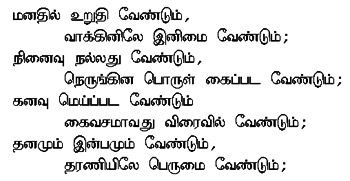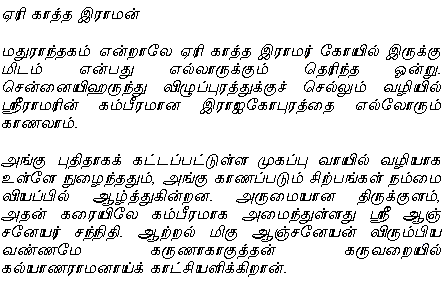Source:-(google.com.pk)
Indian Language Biography
Hindi is the third most widely-spoken language in the world (after English and Mandarin): an estimated 500-600 million people speak the language. A direct descendant of Sanskrit through Prakrit and Apabhramsha, Hindi belongs to the Indo-Aryan group of languages, a subset of the Indo-European family. It has been influenced and enriched by Persian, Turkish, Farsi, Arabic, Portuguese, and English. Hindi is broadly identical with Urdu, the official language of Pakistan, and is closely related to Bengali, Punjabi and Gujerati. A good knowledge of Hindi is therefore likely to be useful to anyone having an interest in the countries of South Asia or in the numerous South Asian communities of the world.
There are no particular difficulties in the study of the language. Hindi inherited its writing system from Sanskrit. The script, Devanagari, is extremely logical and therefore straightforward and easy to learn. Pronunciation is easy because, unlike English, letters are always pronounced exactly the same way. It can be used for both exact and rational reasoning and the expressive form suited for poetry and songs.
The general appearance of the Devanagari script is that of letters 'hanging from a line'. This 'line', also found in many other South Asian scripts, is actually a part of most of the letters and is drawn as the writing proceeds. The script has no capital letters.
Amongst its interesting features is a three-tier level of honorifics, allowing great subtlety in adjusting the level of communication to suit 'formal', 'familiar' and 'intimate' conversational contexts. Thus, the polite communicating of gratitude, etc, is an intrinsic part of the language itself and does not rely solely on separate words for 'please' and 'thank you'.
Hindi is the official language of the Republic of India, and the common second language of Mauritius, Fiji, Trinidad, Guyana and Surinam.
A Brief History
Hindi (and Urdu) is descended from Hindustani, the colloquial form of speech that was spoken in the area in and around Delhi in North India roughly in the ninth and tenth centuries. This language was given the Persian name Hindvi/Hindi - ie the language of Hind, the land of the Indus River - by the Persian-speaking Turks who overran Punjab and the Gangetic plains in the early eleventh century and established what is known as the Delhi Sultanate. Hindvi was constructed largely from Sanskrit loan words that had been 'softened' for 'bol-chal' (common speech). It also absorbed Persian, and through Persian, Arabic loan words, and developed as a mixed or broken language of communication between the newly arrived immigrants and the resident native population of North India. It travelled south and west as the Sultanate expanded beyond the Gangetic plains. It developed into a national language during the colonial period when the British began to cultivate it as a standard among government officials. From the eighteenth century Hindvi began to flower as a literary language. In the course of another century it split into Hindi and Urdu, the former representing a Sanskrit bias and the latter a Persian one. Today, Hindi is written in the Devanagari script while Urdu is written in the Perso-Arabic script.
Sanskrit
No mention of Hindi can be complete without at least touching on its illustrious ancestor, Sanskrit. Sanskrit - meaning refined or perfected - is one of the oldest members of the Indo-Aryan language family, the basis of many of the world's most important language families.
The Sanskrit language has served as the major cultural vehicle of Indian civilisation for many millennia. The vast body of Sanskrit literature, probably the largest collection of literature from the ancient world, thus provides a unique gateway to several aspects of Indian culture. The earliest Sanskrit literature is preserved in the Vedas, collections of ancient hymns and ritual treatises. To preserve Vedic religion, there also evolved a sophisticated 'scientific' literature dealing with ritual, linguistics, mathematics and astronomy; this literature was later expanded to include works in many other areas. The great epics and Puranas provide an inexhaustible source both for the study of Indian mythology and for areas such as law and politics. With the rise of Buddhism and Jainism, rival religions entered into a dialogue that has produced a huge number of religious and philosophical works, including works on logic and philosophy of language. Classical Sanskrit writers also composed a rich literature of poetry and drama. A good starting point for the study of the language is the epics and classical literature, and the works on religion and philosophy, including indigenous linguistics, a field where Sanskrit authors were particularly outstanding.
Sanskrit eventually gave rise to the Prakrit (natural or common) languages, which, in turn, gave rise to the modern Indian languages of today such as Hindi, Bengali, Marathi, Gujarati, Nepali and Singhalese.
Indian Language Biography
Hindi is the third most widely-spoken language in the world (after English and Mandarin): an estimated 500-600 million people speak the language. A direct descendant of Sanskrit through Prakrit and Apabhramsha, Hindi belongs to the Indo-Aryan group of languages, a subset of the Indo-European family. It has been influenced and enriched by Persian, Turkish, Farsi, Arabic, Portuguese, and English. Hindi is broadly identical with Urdu, the official language of Pakistan, and is closely related to Bengali, Punjabi and Gujerati. A good knowledge of Hindi is therefore likely to be useful to anyone having an interest in the countries of South Asia or in the numerous South Asian communities of the world.
There are no particular difficulties in the study of the language. Hindi inherited its writing system from Sanskrit. The script, Devanagari, is extremely logical and therefore straightforward and easy to learn. Pronunciation is easy because, unlike English, letters are always pronounced exactly the same way. It can be used for both exact and rational reasoning and the expressive form suited for poetry and songs.
The general appearance of the Devanagari script is that of letters 'hanging from a line'. This 'line', also found in many other South Asian scripts, is actually a part of most of the letters and is drawn as the writing proceeds. The script has no capital letters.
Amongst its interesting features is a three-tier level of honorifics, allowing great subtlety in adjusting the level of communication to suit 'formal', 'familiar' and 'intimate' conversational contexts. Thus, the polite communicating of gratitude, etc, is an intrinsic part of the language itself and does not rely solely on separate words for 'please' and 'thank you'.
Hindi is the official language of the Republic of India, and the common second language of Mauritius, Fiji, Trinidad, Guyana and Surinam.
A Brief History
Hindi (and Urdu) is descended from Hindustani, the colloquial form of speech that was spoken in the area in and around Delhi in North India roughly in the ninth and tenth centuries. This language was given the Persian name Hindvi/Hindi - ie the language of Hind, the land of the Indus River - by the Persian-speaking Turks who overran Punjab and the Gangetic plains in the early eleventh century and established what is known as the Delhi Sultanate. Hindvi was constructed largely from Sanskrit loan words that had been 'softened' for 'bol-chal' (common speech). It also absorbed Persian, and through Persian, Arabic loan words, and developed as a mixed or broken language of communication between the newly arrived immigrants and the resident native population of North India. It travelled south and west as the Sultanate expanded beyond the Gangetic plains. It developed into a national language during the colonial period when the British began to cultivate it as a standard among government officials. From the eighteenth century Hindvi began to flower as a literary language. In the course of another century it split into Hindi and Urdu, the former representing a Sanskrit bias and the latter a Persian one. Today, Hindi is written in the Devanagari script while Urdu is written in the Perso-Arabic script.
Sanskrit
No mention of Hindi can be complete without at least touching on its illustrious ancestor, Sanskrit. Sanskrit - meaning refined or perfected - is one of the oldest members of the Indo-Aryan language family, the basis of many of the world's most important language families.
The Sanskrit language has served as the major cultural vehicle of Indian civilisation for many millennia. The vast body of Sanskrit literature, probably the largest collection of literature from the ancient world, thus provides a unique gateway to several aspects of Indian culture. The earliest Sanskrit literature is preserved in the Vedas, collections of ancient hymns and ritual treatises. To preserve Vedic religion, there also evolved a sophisticated 'scientific' literature dealing with ritual, linguistics, mathematics and astronomy; this literature was later expanded to include works in many other areas. The great epics and Puranas provide an inexhaustible source both for the study of Indian mythology and for areas such as law and politics. With the rise of Buddhism and Jainism, rival religions entered into a dialogue that has produced a huge number of religious and philosophical works, including works on logic and philosophy of language. Classical Sanskrit writers also composed a rich literature of poetry and drama. A good starting point for the study of the language is the epics and classical literature, and the works on religion and philosophy, including indigenous linguistics, a field where Sanskrit authors were particularly outstanding.
Sanskrit eventually gave rise to the Prakrit (natural or common) languages, which, in turn, gave rise to the modern Indian languages of today such as Hindi, Bengali, Marathi, Gujarati, Nepali and Singhalese.
Indian Language


Indian Language


Indian Language


Indian Language


Indian Language


Indian Language


Indian Language


Indian Language


Indian Language


Indian Language


Indian Language


Indian Language
